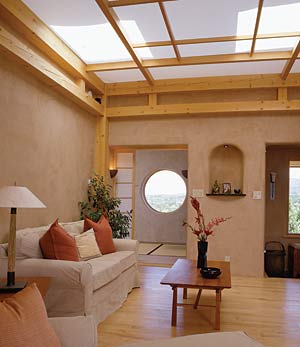American Hardwoods Enhance Healthy, Healing Spaces
Green Certification
While environmental certification and sustainability are not necessarily synonymous, many architects and clients opt to pursue ratings through LEED, GreenGlobesTM and the Green Guide for Health CareTM.
Currently, LEED standards extend credits only to hardwoods certified by the Forest Stewardship Council (FSC). However, there is extremely limited availability of FSC-certified hardwoods because more than three-quarters of U.S. hardwood forests are in private ownership. This fragmented ownership among millions of different individuals and families has posed an obstacle in enrolling hardwood forests in the fee-based, third-party FSC certification program established in the 1990s.
 |
Tias and Surya Little Residence |
Even for architects and clients eager to achieve LEED certification, budget constraints are an important consideration. When pursuing a LEED credit in one area becomes too costly, architects can recoup points in another category. With the Lewis and Clark office building, both architect and client agreed that the cost to procure FSC-certified ash and oak would be too great. Forgoing the LEED-NC materials certification point, the design team made a conscious effort to instead pursue the regional sourcing credit (MR 5.1). This credit requires a minimum of 20 percent of building materials that are manufactured within 500 miles of the project.
"FSC certification is an extra expense that we just didn't have room for in the budget. This client came to BNIM wanting the greenest building possible with the money they had. Cost was a major factor in the decisions we made," notes Hickson.
Obtaining Environmental Credits for Hardwoods
American hardwood products can contribute to a building's green rating under sections of three leading certification systems.
LEED
The LEED (Leadership in Energy and Environmental Design) Green Building Rating System® is a voluntary, consensus-based national standard for developing high-performance, sustainable buildings.
- MR5.1 − Regional materials: 20% manufactured regionally
- MR5.2 − Regional materials: 50% extracted regionally
- MR7 − certified wood
Green Globesâ„¢
The Green Globesâ„¢ system is a green management tool for integrating environmentally friendly design into commercial buildings.
- E.1 Materials with low environmental impact
- E.2 Minimized consumption and depletion of material resources
- G.2.9 Materials specified low-VOC emitting and third-party environmentally certified
Green Guide for Health Careâ„¢, the healthcare sector's first quantifiable sustainable design toolkit, largely mirrors the LEED credit structure.
- MR 5.1-5.2 − Regional Materials
- MR 7 − Certified Wood









